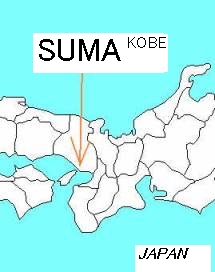
SUMA KOBE IN JAPAN
ENGLISH/JAPANESE
SUMA
SUMA in KOBE where I live is a very beautiful land from ancient times.
This place has many traditions.
And there is a GENKOU-temple at which Basho Matsuo who is a Poet stayed.
The battle of GENJI and HEIKE is very famous.
There is a seashore in Suma which consists of white sand and a pine in Suma.
There are sea side park, Sumaura park, and the Suma Rikyu park in Suma.
the Suma Rikyu park in Suma.
And there is a green stadium Kobe which is proud of the greatest width in Japan.
This photograph is the sunset from Suma.
The left island is the Awaji island.
We can see the Akashi-kaikyo-bridge which is the longest suspension bridge in the world.
KOBE
Located roughly in the center of Honshu, main island of Japan , Kobe is easily accessible by land, sea, and air. It is about 3 hours and 20 minutes from Tokyo by Bullet Train, and 25 minutes by high-speed boat from the Kansai International Airport. Together with Osaka and Kyoto, it forms the focal point for the economy of western Japan.

The Port of Kobe has been a gateway to the world, and is held dear by the many visitors to its shores.
This city charms allude to the dreams of travelers from around the world.
The Port of Kobe
Park, cultural facilities, historic spot.
Sumaura amusement park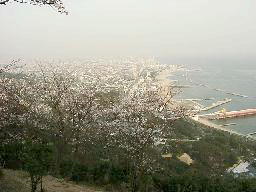
If you go to the Sumaura amusement park and ride on Sumaura Ropeway, you can see the sea and the mountains.
The rotation view stand where you can enjoy the view of 360 degrees, and the lift for the sightseeing is on the mountain.
Then flower of many cherry blossoms are very beautiful in spring.
The rotation view stand which can enjoy the view of 360 degrees, and the lift for the sightseeing is on the mountain.
Operating time : 10:00-17:00 Tuesdays
are not
open.
Admission: free
Charge: 700 yen (both-way charge of Ropeway)
Access: Sanyo Sumaura-yuen Sta
Phone : +81-78-731-2520
The flower of many cherry blossoms are very beautiful in spring.
Sumaura park
Located on the western slopes of the Rokko mountains, originally this land was owned by the Imperial House.
The area, covering 800,000m2 and including Mt .Tekkai, Mt. Takakura, Mt. Aotani and Mt. Hachibuse was purchased from the Imperial family by the City of Kobe and transformed into a park in 1934.
The 2000m long path running through the park and including such landmarks at the "Midori no To" is a splendid place to view cherry blossoms in the spring, the changing color of the leaves in the autumn and for walks in the winter.
The monuments of the haiku poet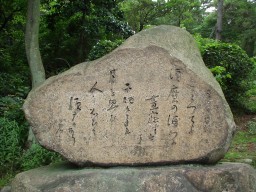
There are the monuments of Shiki Masaoka and Basho and Yosano Buson in the Sumaura
amusement park.
Shiki Masaoka,
the haiku poet, was born in Matsuyama in 1867.
Shiki is well known in Japan for introducing a new style of haiku, a short poetic form, and for enhancing the arts.
After recuperating in Suma near Kobe, in 1895, Shiki came back to his home town Matsuyama.
This monument to the teacher ,Shiki , and the student , Kyoshi is a very unusual monument.
Yosano Buson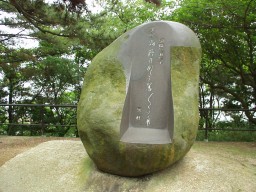
Buson, excellent painter and poet, succeeded in evoking clear images in his picturesque hokkus filled with light.
Haru no umi Hinemosu notari Notari kana / Buson
This poem was written by Yosano Buson (1716-1783) in Sumanoura about the breathtaking view he saw of the Inland sea.
Buson was born in Kema-cho,Miyakojima-ku, in Osaka City and at the age of 51, on his way to Sanuki in Shikoku , he stopped off in Suma.
He was very much inspired by stories he read about Suma and Icinotani in the Gempei Wars and reportedly wrote a letter to one of his disciples saying that imagining these times brings him to tears.
The memorial stone on this site was brought from Sendai and carries an inscription copied from Buson's hand writing.
Basho Matsuo (1644 ~ 1694) 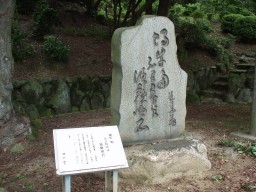
Basho Matsuo is known as the first great poet in the history of haikai (and haiku).
He too, wrote poems using jokes and plays upon words in his early stages, as they were in fashion, but began to attach importance to the role of thought in haikai (especially in hokku) from around 1680.
The monuments of the
battlefield 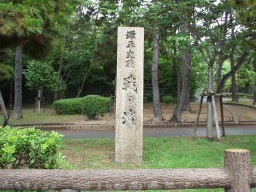
This area is well known as the battlefield of Ichinotani between Gengi clan and Heike clan in 12th century.
Midori no To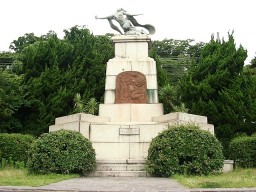
Opened at a Tree planning festival in April 1954 to commemorate the visit of the Showa Emperor (Hirohito) and Empress during the National Greenery Program and was made by Hideo Shintani.
The memorial is through to stand on the site of a battle of the Genpei war(1184).
Suma Rikyu Park
The cottage of the Nishi-Hongangi Ootani family was purchased in 1914.
The cottage became the Emperor's cottage.
Although the cottage was burnt down by war in 1945, The Suma-Rikyu Park was completed it as an Emperor (He was the Crown Prince in that age.) marriage commemoration enterprise in 1970.
Suma Detached Palace Park is situated on a hill about 1Km(0.6mile)from Suma Beach.
It was designed to include green hills on the background with the blue sea in the foreground.
The old traditional beauty combined with modern sense is well arranged in this beautiful park.
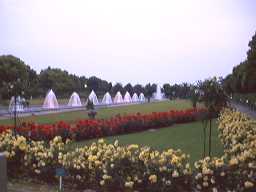
The open space with the fountain which is the main facilities of the park is the beautiful European wind garden which uses water as the motif.
Water which flows from the rest house which imitated Palace gets down from a steps waterfall, it flows to the canal which allotted grass and the flower bed, and then becomes a large fountain dynamically.
The garden of a flower, the garden of a plum or a peach, a flower Shobu garden, a hydrangea garden, an appreciation greenhouse, etc. are situated in inside a garden of width 82.6ha, and the flowers are in bloom through the four seasons.

The night view of the fountain with seven changeable color lights in a very special attraction for the visitors.
The fountain is illuminated at night in summer and autumn.
The walk from the front gate to the rest house is like viewing a magnificent drama.
With the rows of pine trees as the curtain risen the drama slowly begins from the front gate through the middle gate.
Suddenly the setting changes to the lawn square with the main fall and cascades as the climax.
The curtain falls on the blue sea and floating sea beyond.
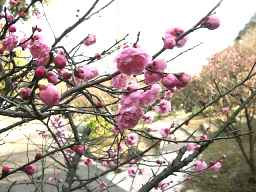
The event in which you will view the plum trees in the garden of the plum will be opened from the middle of February early till early March every year.
Open: 9:00 a.m. - 5:00 p.m.(9:00 a.m. - 5:00 p.m./ 20.Jul-31.Aug)closed Thurs.
Admission : 400 yen /adult, 150 yen/child
Parking Charge: 500 yen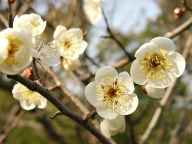
Access: 10 min. walk from Sanyo Tsukimiyama Sta.
Address: 1-1, Higashi Suma ,Suma-ku, Kobe-city,Hyogo,Japan
Phone : +81-78-732-6688
FAX : +81-78-734-6022
http://www.marin.or.jp/ryokuka/rikyu.htm
Suma Aqualife Park
Suma Aqualife Park is not just a building
for sea creatures. 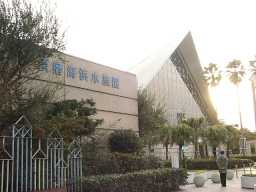 It is designed with a park-like atmosphere, incorporating
plant-life and trees throughout the facilities. The aquarium's main theme is
"how aquatic creatures live." Kobe is called the birthplace of the
aquarium in Japan. A modern aquarium," Waraku-en" with Japan's first
circulating, filtered tank was built in 1897. "Suma Aquarium" was
built in 1957, and was considered to be the biggest aquarium in East Asia. After
renovation, the aquarium was renamed "Suma Aqualife Park" and its
opening in 1987 then pioneered a nationwide boom in big-tank exhibitions.
It is designed with a park-like atmosphere, incorporating
plant-life and trees throughout the facilities. The aquarium's main theme is
"how aquatic creatures live." Kobe is called the birthplace of the
aquarium in Japan. A modern aquarium," Waraku-en" with Japan's first
circulating, filtered tank was built in 1897. "Suma Aquarium" was
built in 1957, and was considered to be the biggest aquarium in East Asia. After
renovation, the aquarium was renamed "Suma Aqualife Park" and its
opening in 1987 then pioneered a nationwide boom in big-tank exhibitions.
Open: 9a.m. - 5p.m; closed Wed.
Admission: \1300 for adult, \800 for high school student, \500 for child
Access: 10 min. walk from Sanyo Tsukimiyama Sta.
 Suma
Beach is the beautiful seashore of about the length 2km that it is composed of the white sand and the blue pine.
Suma
Beach is the beautiful seashore of about the length 2km that it is composed of the white sand and the blue pine.
Suma seashore appeared many times in the history from the old days, and a citizen had had familiarity.


The beach volleyball convention is held in the seashore every
year.
There was an event in the Christmas in 2001 by sea side park.
Access: JR Suma station
The flower of the cherry blossoms of a
Miyohouji-river park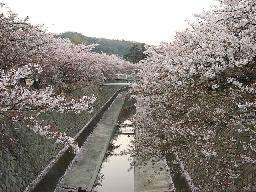
The Miyohouji -river park is the beauty spot of the cherry blossoms of Kobe city No.1 in early April.
Fishing Park
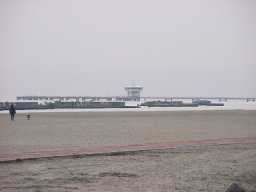
Artificial fishing sites where even a beginner can
catch a big one with no difficulty; you can rent all the necessary tools.
Open 6a.m. - 7p.m (- 9p.m. in summer); closed Tues.
Admission: \200 for adult, \100 for child; \1,200 to fish for 4 hours.
Kobe Green Stadium 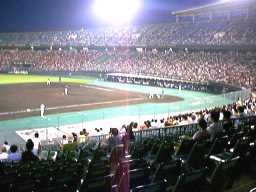
Part of a larger sports complex, Green Stadium lies near the Univa Memorial Track Field, Green Arena Kobe and Sogo Undo Koen (Park).
There are few restaurants or convenience stores near the ballpark, so it may be a good idea to pick up your snacks and beverages before you get on the train to Green Stadium.
Or you could reserve a seat at the Sky Restaurant, which lies along Green Stadium's rim, behind home plate.
Enjoy the city's famous Kobe beef while you watch a game. But if the restaurant is too crowded, you can also find okonomiyaki (Japanese pancakes) and other food inside the park.
Matsukaze Murasamedo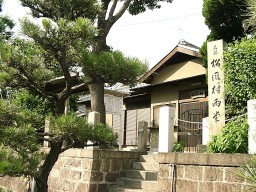
In 887 Ariwara Yukihira, son of Aboshinno, was banished to Suma after angering the emperor Koko, although it is not known exactly where he lived. One day, he met two sisters, Moshiho and Kofuji who were drawing water from the sea to make salt. He named them "Matsukaze" and "Murasame".
It is said that they lived together with Yukihira and worked very hard for him until he returned to Kyoto three years later. The story of the parting of Yukihira and the sisters has been passed down in the from of noh plays and poems. The sisters missed Yukihira deeply and lived in loneliness in what is now known as Matsukaze Murasamedo. The sisters later returned to their home in Tainohata where they would gaze at their reflections in a pool and think of Yukihira. That pool still exists in Tainohata and is known as Sugatami no ido.
Five Storied Stone Stupa 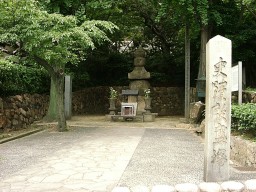
Atsumorizuka
This area is well known as the battlefield of Ichinotani between Gengi clan and Heike clan in 12th century.
It is said this stupa was dedicated to TAIRANO Atsumori,young knight of Heike who was killed by KUMAGAI Naozane in 1184 at age 16.
Five storied stupa is a tombstone consist of five different parts.
From the bottom ,the scquare part symbolises earth, the circular part, wind and the flaming shape
part, air.
In buddhism it indicates five elements which exist in the material world.
Antoku Dairiato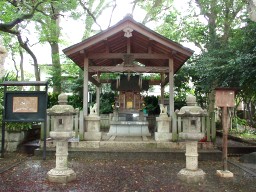
(Legendary Site of Emperor Antoku's Palace)
The emperor Antoku was the son of Kenreimon-in Tokuko, who was the daughter of Kiyomori Taira. He ascended the throne at the age of 2. He first set up his capital in Fukuhara, Kobe but it was soon moved to Kyoto. When Kyoto was invaded by Kiso Yoshinaka, the Heike clan were defeated at the Battle of Gempei and fled to the west. At Dan no Ura, on March 24th 1185, it is said that the infant emperor's grandmother, Ni no Ama, held the emperor in her arms and plunged together with him to their death into the sea. It is believed that on the trip west, a temporary palace for the emperor was set up at Ichi no Tani. A temple was later built on the site of the palace to pray for the soul of the young emperor. In the Genroku Period (1687-1703), the famous poet Matsuo Basho (1644-1694) visited the site.
The Grave of Yoich
Nasu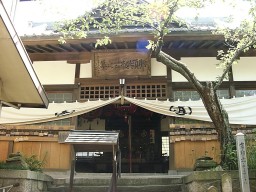
This place is Known as Nasu Shrine, and contains the grave of Yoichi Nasu.
In Yashima, during the Gempei Wars, the Heike clan attached a fan to a bamboo pole atop the prow of a small boat and challenged the Genji to shoot it with their arrows.Yoichi loosed a single arrow and knocked down the fan, immediately becoming famous for his archery prowess.His victory at the battle of Ichi no Tani is often attributed to his having prayed for victory at Kitamuki Hachiman Shrine.
After the battle, Yoichi became a priest and traveled the countryside.It is said that he became sick and died at the Myohoji Temple.The villagers built a grave and interred him here.
Site of Shigehira
Taira's Capture
It is Written in the famous book "Tales of the Heike that during a battle between the Genji and Heike on February 7th 1184.
Vice General Shigehira Taira, who commanded the garrison at Higashimon Ikuta no Mori and was defeated by the Genji force, fled west along the Sanyodo road where his mount was shot from under him by an arrow shot by Genji Shosaburo Ienaga and he was captured alive.
Shrine and Buddhist Temple
Sumadera Temple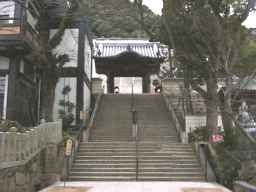
Built in 886, it had 12 priest lodges of which only three remain today. The principal image of the temple is a wooden sculpture of "kannon" with eleven heads. With reservation you can enjoy the performance of "Suma Koto," a traditional one-string harp.
The temple contains monuments to many famous people
such as the poets Matsuo Basho and Masaoka Shiki.
Admission: free
Access: 10 min. walk from Sanyo Sumadera
Sta
Phone : +81-78-731-0416
Tsunashiki Tenmangu Shrine
The Tsunashiki Tenmangu Shrine is Described in the old book "Nihon ni-ju-gosha no hitotsu" (one of the 25 shrines of Japan) under the name 'Settsu no Kuni Tsunashiki Tenjin' and has Sugawara Michizane as its principal deity.
Michizane was a Heian period(794-1192) court official who was sent to Kyushu for demotion.
On the way his vessel met with a storm.
In order to escape the wind and rain, he
landed in Suma and stayed for night. 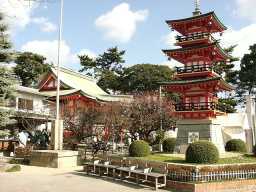
The fisherman of the village wound a large round mat from a thick fishing net rope and placed it under a pine tree for him to rest upon.
In 979, out of remembrance and respect for Michizane, the people of the village constructed the shrine.
Michizane is thought of as a deity of study, so many students can be seen praying here, especially on the shrine's festival day; January 25th .
Michizane wrote a poem about ume (Japanese apricot) and so many people also come to play here during ume blossom season.
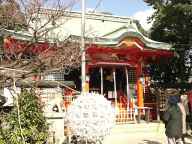
Admission: free
Access: 10 min. walk from JR Suma Sta
Genkoji Temple
Genkoji Temple is a Jodo Shinshu temple dedicated to Amida Nyorai and was built by Jokyo Shonin in 1514.
The temple is believed to stand on the site of the house of Hikaru Genji, the main character in the Tales of the Genji.
Murakami Teisha Shrine
In the Heian Period (794-1192), the minister Moronaga Fujiwara, a master of the biwa (Japanese lute) intended to travel to China to perfect his musical skills.
On his way, as he slept in Suma, the sprits of emperor Murakami and princess Nashitsubo appeared in his dream and taught him the secrets of playing the biwa.
He therefore gave up his intention to go to China and it is said that he buried his "Shishimaru" biwa in this area before returning home.
This incident was commemorated in the Noh song "Genjo" and the burial place of the biwa is believed to be somewhere within the shrine compound.
Although the exact location is unknown, a mound behind the shrine building is known as "Biwazuka" (biwa burial place).
TAINOHATA HACHIMANGU Shrine
Shrine
This shrine was built in 1175 in the reign of the emperor Takakura and dedicated to the god said to have been relocated from Nantaizan Hachiman Shrine.
According to the Zoku Nihonki, the second oldest Japanese historical book, in 770the royal court Nara, fearful of diseases entering the capital territory sent messengers to ten border point to pray for the prevention of these diseases.
Itayado Hachiman Shrine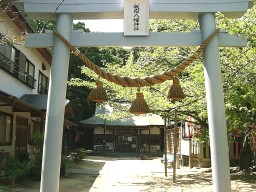
When Sugawara Michizane rested here on the way to Kyushu after being banished there, the people of the village made a wooden fence around him to shelter him from the cold night wind.
The place name Itayado comes from that fence (ita=wooden planks, yado=place to stay).
It is said that Takekami Hachiman Daijin and Michizane were defied here.
Shosei Shrine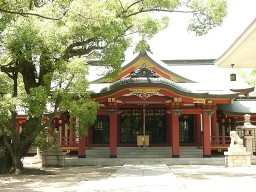
In the first year of Eien (987), in the regin of the Icijo emperor, the deity Kishuu Kumamoto no Okami (Dai Gongen) was divided between five villagers; Ote, Higashi Suma, Noda, Komagabayashi, Itayado and defied as their guardian god.
The Heike, who moved their capital to Fukuhara also greatly revered this shrine.
In the Tokugawa period, this shrine was called Sumashoryo Dai Gongen and in Meiji 4 (1871), the shrine's name was changed to Shosei Shrine.
The guardian deity is still revered throughout the Suma area to this day.
Isotakeru no Mikoto, son of Susano no Mikoto is also deified in this shrine.
Keiunji Temple
Keiunji Temple is a Rinzai-shu sect temple dedicated to Shaka-Munibutsu and was built in 1336.
During the Battle of Minamotogawa, there appeared a priest who caught arrows shot at the camp of Takeuji Ashikaga and contributed to Takeuji's victory.
Regarding the priest as an incarnation of Jizo, Takeuji's built Genpukuji Temple, deifying the priest as "yahiroi Jizo"(arrow-Catching Jizo).
The above story relates to the original Keiunji Temple, but unfortunately, Yahiroi Jizo was destroyed in two fires in 1953.
Shofukuji Temple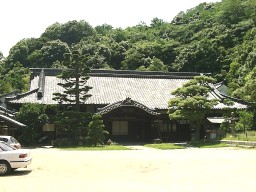
In the first year of Eien (987), Shoraku Shonin divided Kishu Gongen and founded this temple as Shoryo Gongen.
This was originally a large temple with 7 main temple buildings and accommodation for 36 residences however , because of destruction by natural disasters and war only a few buildings still exist.
It is said that Takauji Ashikaga came here to commit harakiri.
This temple is part of the Shingon sect of Buddhism, whose principal image of Buddha is Shokannon Bosatsu.
Zenshoji Temple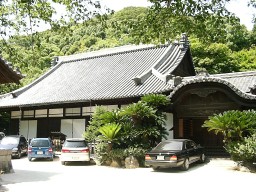
The temple was founded by Getsuan Zenshi around 1356-60, and its full name is Jinbuzen Zenshoji.
This temple's principal Buddhist image is Juichimen Kannon (11-faced Kannon).
This temple is also a well-known place for viewing the beautiful red Japanese maple leaves in autumn.
Myohoji Temple
This temple is one of the oldest in Suma.
The official name of this Shingon-shu sect temple is Nyoizan Myohoji.
The temple was established by the monk, Gyoki, in 738 and was dedicated to "Bishamonten".
The temple originally consisted of 7 main buildings and accommodation for 37 yesidences.
Kitamuki Hachiman Shrine
Kitamuki Hachiman Shrine is said to have been built in 1484.
The name of this small shrine means "North-facing Hachiman Shrine".
Hagi No Tera Temple
Long ago, this then Tendai-shu sect temple was known as Myoko-ji Temple and is said to date from around 650 years ago.
Presently, this temple is only temple of the Obaku-shu sect of Buddhism in Kobe City.
The temple is dedicated to Amida Nyorai.
The many varieties of hagi (Japanese bush clovers) which glow in the grounds begin to bloom in September, pleasing the many visitors who come during this time.
Kuruma Otoshi Shrine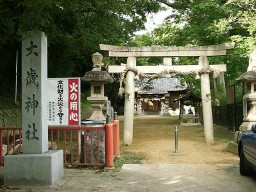
Otoshi Shrine is said to have been built in 646 and was originally located in Odo, on the southern part of the Miki Road.
Due to the size of the shrine building, it was known as Odo (different characters, this time meaning "Large Hall").
The name later became corrupted to "Kuruma Odo".
Due to the destruction of records in the numerous fires throughout this area's history, details about this shrine are scarce.
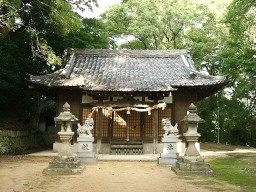
Shirakawa Otoshi Shrine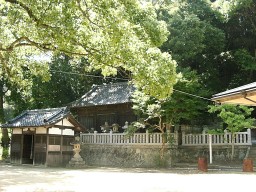
In 995, this area suffered a terrible epidemic.
It is said that in addition to Otoshigami, a god of harvest, this shrine was also built to deify Susano no Mikoto, in the hope that building it would put an end to the disease.
In a large fire in 1877, several valuable treasures such as poems written by poets appearing in the "San-ju rokkasen"(36 Poets) anthology were destroyed.
Long ago, Noh plays Known as "Go-Menko" and bow rituals, were held here.
Public facilities.
The Suma Library
Established as Kobe's number eighth library in September, 1981. In the middle of a green park and in the neighborhood of the town hall, gymnasium and other public institutes. Particularly general and children's books. In the 'Rediscovering Our Town' corner you can find materials on the theme 'Sea and Sports.' There is a storytelling (by volunteers) on the second Saturday of each month.
Address Suma-ku Nakajima-cho 1-2-3
Tel 078-735-7444
Fax 078-735-4313
JR Suma station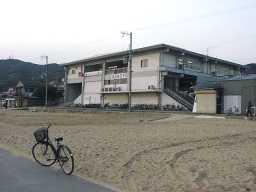
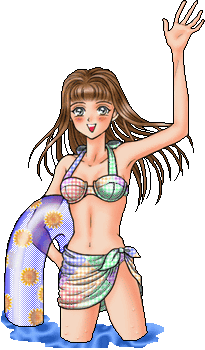
If you get down to on the south, there is Suma beach .
Hotels
| NAME | ROOMS | LOCATION | PHONE | NEAREST STA |
| SEAPAL SUMA | 45 | Sumaura-douri,Suma-ku | +81-78-731-6815 | JR Suma |
| Kotobukiro | 53 | Sumadera-cho,Suma-ku | +81-78-731-4351 | Sanyo Sumadera |
| Enmei | 16 | Sumadera-cho,Suma-ku | +81-78-731-4051 | Sanyo Sumadera |
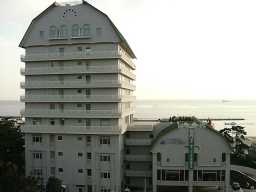
SEAPAL SUMA
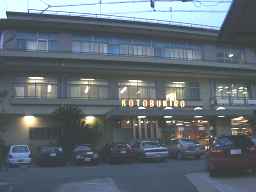 Kotobukiro
Kotobukiro
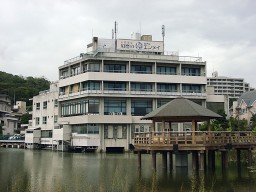 Enmei
Enmei